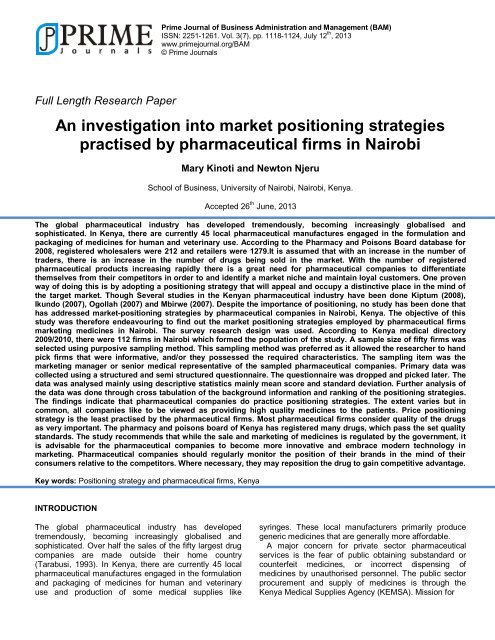Full Article (PDF) - Prime Journals
Full Article (PDF) - Prime Journals
Full Article (PDF) - Prime Journals
Create successful ePaper yourself
Turn your PDF publications into a flip-book with our unique Google optimized e-Paper software.
<strong>Prime</strong> Journal of Business Administration and Management (BAM)<br />
ISSN: 2251-1261. Vol. 3(7), pp. 1118-1124, July 12 th , 2013<br />
www.primejournal.org/BAM<br />
© <strong>Prime</strong> <strong>Journals</strong><br />
<strong>Full</strong> Length Research Paper<br />
An investigation into market positioning strategies<br />
practised by pharmaceutical firms in Nairobi<br />
Mary Kinoti and Newton Njeru<br />
School of Business, University of Nairobi, Nairobi, Kenya.<br />
Accepted 26 th June, 2013<br />
The global pharmaceutical industry has developed tremendously, becoming increasingly globalised and<br />
sophisticated. In Kenya, there are currently 45 local pharmaceutical manufactures engaged in the formulation and<br />
packaging of medicines for human and veterinary use. According to the Pharmacy and Poisons Board database for<br />
2008, registered wholesalers were 212 and retailers were 1279.It is assumed that with an increase in the number of<br />
traders, there is an increase in the number of drugs being sold in the market. With the number of registered<br />
pharmaceutical products increasing rapidly there is a great need for pharmaceutical companies to differentiate<br />
themselves from their competitors in order to and identify a market niche and maintain loyal customers. One proven<br />
way of doing this is by adopting a positioning strategy that will appeal and occupy a distinctive place in the mind of<br />
the target market. Though Several studies in the Kenyan pharmaceutical industry have been done Kiptum (2008),<br />
Ikundo (2007), Ogollah (2007) and Mbirwe (2007). Despite the importance of positioning, no study has been done that<br />
has addressed market-positioning strategies by pharmaceutical companies in Nairobi, Kenya. The objective of this<br />
study was therefore endeavouring to find out the market positioning strategies employed by pharmaceutical firms<br />
marketing medicines in Nairobi. The survey research design was used. According to Kenya medical directory<br />
2009/2010, there were 112 firms in Nairobi which formed the population of the study. A sample size of fifty firms was<br />
selected using purposive sampling method. This sampling method was preferred as it allowed the researcher to hand<br />
pick firms that were informative, and/or they possessed the required characteristics. The sampling item was the<br />
marketing manager or senior medical representative of the sampled pharmaceutical companies. Primary data was<br />
collected using a structured and semi structured questionnaire. The questionnaire was dropped and picked later. The<br />
data was analysed mainly using descriptive statistics mainly mean score and standard deviation. Further analysis of<br />
the data was done through cross tabulation of the background information and ranking of the positioning strategies.<br />
The findings indicate that pharmaceutical companies do practice positioning strategies. The extent varies but in<br />
common, all companies like to be viewed as providing high quality medicines to the patients. Price positioning<br />
strategy is the least practised by the pharmaceutical firms. Most pharmaceutical firms consider quality of the drugs<br />
as very important. The pharmacy and poisons board of Kenya has registered many drugs, which pass the set quality<br />
standards. The study recommends that while the sale and marketing of medicines is regulated by the government, it<br />
is advisable for the pharmaceutical companies to become more innovative and embrace modern technology in<br />
marketing. Pharmaceutical companies should regularly monitor the position of their brands in the mind of their<br />
consumers relative to the competitors. Where necessary, they may reposition the drug to gain competitive advantage.<br />
Key words: Positioning strategy and pharmaceutical firms, Kenya<br />
INTRODUCTION<br />
The global pharmaceutical industry has developed<br />
tremendously, becoming increasingly globalised and<br />
sophisticated. Over half the sales of the fifty largest drug<br />
companies are made outside their home country<br />
(Tarabusi, 1993). In Kenya, there are currently 45 local<br />
pharmaceutical manufactures engaged in the formulation<br />
and packaging of medicines for human and veterinary<br />
use and production of some medical supplies like<br />
syringes. These local manufacturers primarily produce<br />
generic medicines that are generally more affordable.<br />
A major concern for private sector pharmaceutical<br />
services is the fear of public obtaining substandard or<br />
counterfeit medicines, or incorrect dispensing of<br />
medicines by unauthorised personnel. The public sector<br />
procurement and supply of medicines is through the<br />
Kenya Medical Supplies Agency (KEMSA). Mission for





![See Full Article [pdf] - prime journals limited](https://img.yumpu.com/49292987/1/190x245/see-full-article-pdf-prime-journals-limited.jpg?quality=85)



![See Full Article [pdf] - Prime Journals](https://img.yumpu.com/44526114/1/190x245/see-full-article-pdf-prime-journals.jpg?quality=85)


![See Full Article [pdf] - prime journals limited](https://img.yumpu.com/42270022/1/190x245/see-full-article-pdf-prime-journals-limited.jpg?quality=85)

![See Full Article [pdf] - Prime Journals](https://img.yumpu.com/41607332/1/190x245/see-full-article-pdf-prime-journals.jpg?quality=85)
![See Full Article [pdf] - Prime Journals](https://img.yumpu.com/41231982/1/190x245/see-full-article-pdf-prime-journals.jpg?quality=85)
